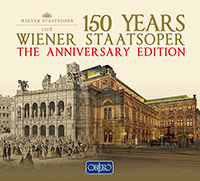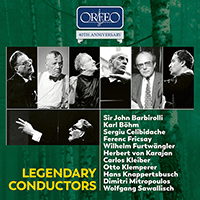Hans Knappertsbusch
Hans Knappertsbusch was born into a prosperous family whose wealth was gained from manufacturing. While still at school he conducted various orchestras, but as a result of paternal opposition to a career in music he studied philosophy at Bonn University. Nonetheless he also studied music at the Cologne Conservatory, where his teachers included Fritz Steinbach, one of the foremost interpreters of the music of Brahms. During 1910 Knappertsbusch worked as an unpaid assistant to Siegfried Wagner and Hans Richter at the Bayreuth Festival, and in the same year he accepted a permanent conducting position at the opera house at Muhlheim, staying there until 1912 when he moved to a similar position at Bochum. He returned to his home town, Elbersfeld, in 1913 as permanent conductor at the local opera house, and also led one of the first productions of Wagner’s Parsifal to be given outside Germany, in Holland.
Throughout World War I Knappertsbusch stayed at Elbersfeld and in 1918 was appointed first conductor at the Leipzig Stadttheater. The following year he moved to a similar position at Dessau, where he was promoted to chief conductor in 1920, becoming one of the youngest conductors to hold such a position in Germany at this time. Two years later he made his debut in Munich, conducting orchestral concerts, and was invited to succeed Bruno Walter as chief conductor at the Bavarian State Opera where he made his debut with Wagner’s Tristan und Isolde in October 1922. He also appeared at the Zoppot Opera Festival, known as the ‘Bayreuth of the North’. Knappertsbusch made another successful debut, in Vienna with the Vienna Symphony Orchestra, during the following year and first conducted the Vienna Philharmonic Orchestra in 1929 at the Salzburg Festival. Here he enjoyed great success and was invited to return for the Festival the following year, also appearing in the Vienna Philharmonic’s subscription series for the first time in 1934 alongside conductors of the calibre of Furtwängler, Toscanini and Walter.
Following the assumption of power in Germany by the National Socialist Party, and his subsequent refusal to join it, Knappertsbusch was forced to resign from his position at the opera in Munich in 1936. He moved to Vienna where he was active at the State Opera and the Salzburg Festival as well as with the Vienna Philharmonic; and at the invitation of Sir Thomas Beecham he made his debut at the Royal Opera House, Covent Garden, in 1937, conducting Richard Strauss’s Salome. During World War II Knappertsbusch remained in Vienna, but also broadcast and recorded with German orchestras such as the Berlin Philharmonic. He conducted the last performance at the Vienna State Opera prior to its destruction by bombing: Wagner’s Götterdämmerung (30 June 1944).
In 1945 Knappertsbusch returned to Munich, but after giving several orchestral concerts was banned from conducting by the Allied forces. However he was cleared of collaboration with the Nazis in 1947 and, still in Munich, re-commenced his activities, leading the Munich Philharmonic Orchestra in the celebrations of the fiftieth anniversary of Brahms’s death. He participated at the Salzburg Festival each year between 1949 and 1955, and in 1951 returned to the Bayreuth Festival to conduct Wieland Wagner’s legendary production of Parsifal; thereafter he appeared at Bayreuth annually, except for one year, up to 1964, being a noted exponent of the Ring cycle there. Knappertsbusch took up his old post of chief conductor at the Bavarian State Opera once again in 1954, retaining this until his death, and returned to the Vienna State Opera to conduct Der Rosenkavalier as one of the productions given to mark the re-opening of the theatre in the autumn of 1955. A rare appearance outside Austria and Germany occurred in 1956 when he conducted Tristan und Isolde with Astrid Varnay at the Paris Opera. Having suffered a bad fall in 1964, from which he never fully recovered, he died in 1965.
Kna, as Knappertsbusch was often affectionately known, firmly believed, as did Wagner, in the inspiration of the moment. As the historian of the Vienna Philharmonic, Otto Strasser, has pointed out, he believed that the doctrine contained within Wagner’s idea of ‘tempo modification’ was ‘central to every performance’. Kna was thus likely to adjust tempi if he felt that the results ‘…sounded particularly beautiful, and this imparted a pronounced individuality to his interpretation of a work.’ An extension of this conducting style is the characteristic of positively seeking spontaneity of expression. Thus throughout his life Kna would continually surprise audiences with impromptu discoveries within even well-known scores, although such revelation of previously obscured detail was still set within a careful moulding of the overall architecture of the piece. Knappertsbusch’s performances relied on a broad underpinning of orchestral mass, and moved at a different pace and with a different tone and atmosphere to those of Furtwängler, for instance. Technically Knappertsbusch was undemonstrative as a conductor: in this respect, comparison with Richard Strauss was often made. At his debut in 1923 with the Vienna Symphony Orchestra his restrained style of conducting was noted and favourably received; as the commentator Erich Deiber noted laconically, ‘Knappertsbusch is the only conductor who can transform a pianissimo into a fortissimo by moving his cufflinks.’ With this lack of rostrum showmanship went a high degree of platform modesty, contemporaries noting that Kna rarely allowed himself and his orchestra more than two curtain calls.
Knappertsbusch’s reliance on feelings and musical instinct, drawn from the Wagnerian interpretative aesthetic and manifesting itself in the search for spontaneous expression and tempo modification, naturally led to a positive dislike of rehearsals as being an inhibiting influence. The influence of many years of working within the old German operatic system can also be observed in this trait: conductors were frequently expected to take command of often complex works without rehearsal and to survive in such circumstances was an acid test of ability as a conductor. But success bred tremendous confidence, which was immediately noticed when Kna took the stand, for instance when he made his debut in Vienna. It also gave rise to numerous anecdotes, typical of which is the following quoted in Roger Vaughan’s biography of Herbert von Karajan: ‘One time he was going over Tchaikovsky’s Fifth with the Vienna Philharmonic. He came to the second movement, with the horn solo, and said, “Let’s start”. He did a few bars, stopped, and said, “See you this evening. You know the piece, I know the hall.” The solo horn protested, “I am new, I have never played this piece in concert.” Knappertsbusch said, “It is beautiful music—you will love it.”’ It would be wrong however to think of Knappertsbusch as lax in performance. In his obituary of Kna written for Opera magazine, Hans Hotter tells the story of how, having inadvertently omitted a crucial sung sentence in a certain opera, at subsequent performances he noticed that Kna ‘…had risen from his stool to his full height, turned his baton upside down and was shaking the thick end of it at me with a threatening and meaningful gesture. It would not have needed much more to make me forget my part again! The same scene was re-enacted in a series of performances of this opera throughout the following years.’
Given his particular artistic personality, it is hardly surprising that Knappertsbusch was uncomfortable with the process of recording in the studio: an aesthetic based on spontaneity and variation stands in complete opposition to one based during the latter part of his lifetime on exact repetition both in recording and in reproduction. In many respects his studio recordings now stand as an addendum to the increasingly rich legacy of recordings of live performances. These represent a far more appropriate means of understanding Knappertsbusch’s high-risk strategy of relying on the magic of the moment to reveal musical insights. In this respect the formal hierarchy of the gramophone—studio recording above live performance—is neatly reversed.
In the field of opera the Knappertsbusch legacy is inevitably focused upon Bayreuth, which may be seen as his spiritual home. His readings of Parsifal (1951) and Der Ring des Nibelungen (for instance, 1957) are fine examples of his Wagner conducting. From Munich there exist recordings of characteristic performances of Tristan und Isolde (1950) and Der Rosenkavalier (1957), and the latter opera from Vienna also, given in 1955. A commercial recording from Decca with the American bass-baritone George London of Wotan’s Farewell from Die Walküre is very powerful. The cornerstone of Knappertsbusch’s symphonic repertoire was the music of Anton Bruckner. As early as the 1920s and 1930s he was conducting ‘Bruckner Evenings’ throughout Germany, and his ‘live’ discography is extensive: of especial value is the performance of the Symphony No. 7, given at the Salzburg Festival in 1949 with the Vienna Philharmonic. Also of note are a Munich performance of the Symphony No. 3 (1954), and a very powerful, granite-like, Symphony No. 9 with the Berlin Philharmonic from 1950. Decca recorded Symphonies Nos 3, 4 and 5 with Knappertsbusch and the Vienna Philharmonic, and these are strong readings, if without the cumulative power of the live performances. Among much fine Brahms from Knappertsbusch is an immensely powerful performance of the Symphony No. 3 coupled with the Tragic Overture, given with the Vienna Philharmonic at the Salzburg Festival in 1955. Zubin Mehta, who observed Knappertsbusch while a student in Vienna, noted how he was able to inject great tension into the music which he was conducting: ‘He could play the Brahms Symphony No. 3 at half the tempo and you’d still not be bored, because it would make musical sense.’
Knappertsbusch’s success with heavyweight works and composers has obscured his penchant for lighter music. Two late Decca stereo LPs featured this repertoire and contain some extraordinary readings of music by Johann Strauss II and minor masters such as Ziehrer and Komzak (who would have been contemporaries of Kna’s youth). Also of note are his accompaniments to three concerto recordings by Sir Clifford Curzon, of Beethoven’s Piano Concertos Nos 4 and 5 and Brahms’s Piano Concerto No. 2. Recordings of live performances of these two Beethoven concertos with another master of the keyboard, Wilhelm Backhaus, have also been preserved.
© Naxos Rights International Ltd. — David Patmore (A–Z of Conductors, Naxos 8.558087–90).





































